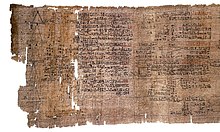Ahmes
This article will address the topic of Ahmes, a concept that has gained relevance in recent years due to its impact on various aspects of daily life. Since its emergence, Ahmes has captured the attention of experts and the general public, generating debates, research and different interpretations. Over time, Ahmes has become a topic of interest both in academia and in daily conversation, and its influence has spread to multiple areas, becoming a fundamental reference point for understanding current phenomena. In this review, different perspectives on Ahmes will be explored, in order to provide a broad and enriching vision of its relevance and impact on contemporary society.

Ahmes (Ancient Egyptian: jꜥḥ-ms “, a common Egyptian name also transliterated Ahmose) was an ancient Egyptian scribe who lived towards the end of the Fifteenth Dynasty (and of the Second Intermediate Period) and the beginning of the Eighteenth Dynasty (and of the New Kingdom). He transcribed the Rhind Mathematical Papyrus, a work of ancient Egyptian mathematics that dates to approximately 1550 BC; he is the earliest contributor to mathematics whose name is known. Ahmes claimed not to be the writer of the work but rather just the scribe. He claimed the material came from an even older document from around 2000 B.C.
See also
References
- ^ "The Rhind Mathematical Papyrus". britishmuseum.org. Retrieved 2017-09-18.
- ^ Pickover, Clifford A. (2009), The Math Book: From Pythagoras to the 57th Dimension, 250 Milestones in the History of Mathematics, Sterling Publishing Company, Inc., p. 36, ISBN 978-1-4027-5796-9.
- ^ Derbyshire, John (2006), Unknown quantity: a real and imaginary history of algebra, National Academies Press, p. 29, ISBN 978-0-309-09657-7.
- ^ "Ahmes - Biography".